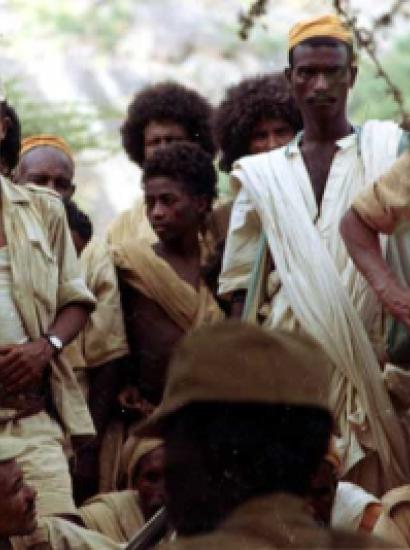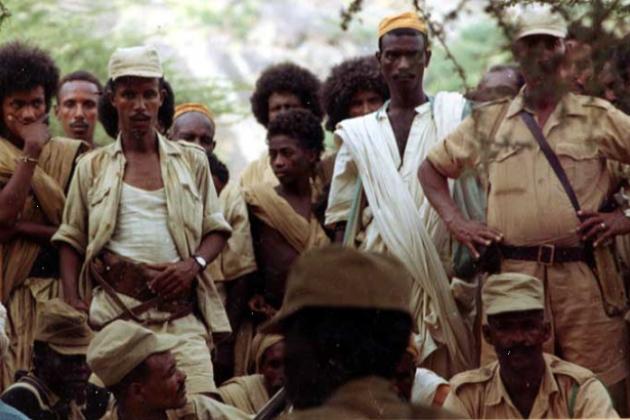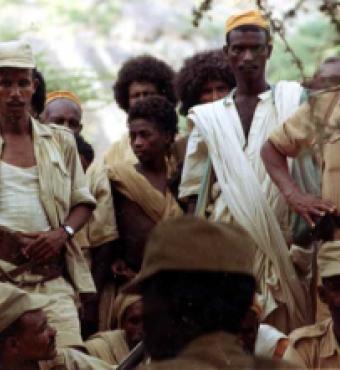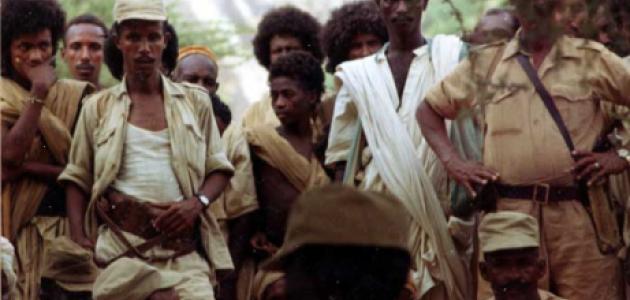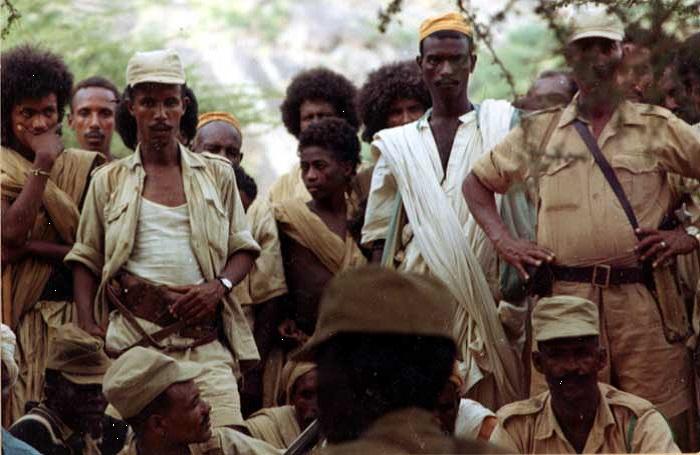

At times, stories behind archival collections can be as important as the collections themselves. You've heard of being in the right place at the right time? This is a story of being in the right place at the right time, for the wrong reasons.
In the late 1960s, Jack Kramer, now a retired journalist, donated his papers to the Hoover Institution Archives. The papers include letters between Jack Kramer and Osman Saleh Sabbe, Mohamud Dinai, Kidane Kiflu, and Woldeab Woldemariam, well-known personalities in the political landscape of Eritrea’s independence movement, as well as a rare sound recording, which is the focus of this post.
The story begins in London, England, over a £5 bet. The time was the 1960s, a decade Kramer called “a storm that seemed to rage forever.”1 Kramer bet £5 that he would arrive before his friend in Addis Ababa, Ethiopia, overland.
The purpose was to fulfill two friends’ respective childhood daydreams. For Kramer’s friend it was to reach the “Land of Prester John.” For Kramer it was to be shipped out to Dar (el Salaam) past Mogadishu and Zanzibar.
The state of Kramer and his friend at the time of the bet? "Gin-drunk."2
Here are some details from Kramer’s journey that I picked out from his book:
- The European-staffed Ethiopian Embassy told Kramer that he did not need a visa for Ethiopia and that he could get it at the border.
- Kramer made his way to Port Sudan and then to Kassala, Sudan. On arrival, he asked the Ethiopian Consulate in Kassala for a visa and was told that they would have to contact Addis Ababa for a reply. He was asked to wait.
- For the first time, he heard about Eritrea and its fight against Ethiopia in Kassala. Kidane Kiflu introduced himself to Kramer.3
- The following evening, Kidane Kiflu asked Kramer if he was interested in meeting “freedom fighters” in the mountains of Eritrea. Kramer recalled the occasion “as if he [Kidane] were inviting me to dinner.”4
- Kramer got a firm no from the Ethiopian Consulate.
- Kramer took up Kidane’s offer and decided to go to Eritrea without an exit visa from Sudan or an entrée visa from Ethiopia.
- Kramer crossed the border and traveled inside Eritrea with the Eritrean Liberation Front (ELF) fighters for almost a month.
- Kramer and his escort arrived near Halhal, Eritrea, a few days after the Battle of Halhal. At the time of the battle they were fifteen kilometers (about ten miles) southwest of Halhal.5
Before continuing with the consequences of Kramer’s travel, I want to give a brief historical background of Eritrea:
- Eritrea was Italy’s first colony. Italy ruled Eritrea from 1890 until 1941.
- Eritrea was the first to be freed by the Allied forces in 1941. As a result, Great Britain ruled Eritrea from 1941 to 1952.
- From 1952 until 1962 Eritrea was federated with Ethiopia.
- In 1962 Ethiopia abolished the federation and ruled Eritrea until 1991.
- In 1961 the ELF began the armed struggle against Ethiopia.
- By 1965, the ELF had divided Eritrea into five military zones/divisions (modeled after Algeria’s Front Liberation Nationale [FLN]) to fight against Ethiopian forces in Eritrea.6
- The Supreme Council (SC), based in Cairo, Egypt, was at the head of the organizational structure of the ELF, followed by the Revolutionary Command (RC), which was based in Kassala, Sudan. The main task of the RC was to coordinate the five zones inside Eritrea. The leading figures in the SC vied for control of one or another of the zones, bypassing the RC.
- In 1967 Ethiopia conducted a major counterinsurgency campaign by attacking the zones one at a time, knowing there was no coordination among them. The zonal structure of the front proved incapable of responding to the Ethiopian offensive and soon after led to a political crisis within the ELF.
- A reform movement called Enslah emerged with the intention of creating a unified army and command structure. In June and July 1968 military commanders and political commissars of the third, fourth, and fifth zones met and agreed to get rid of the zonal divisions, unify the army under a single command, and so forth. During the meeting commanders of the first and the second zones were absent.7
It was during the clandestine activities of the Enslah and the strategic political positioning within the ELF that Jack Kramer arrived in Eritrea in September 1968. Hence, the historical value of the letters and the sound recording of the Jack Kramer papers, especially when analyzed within this historical context.
The Battle of Halhal was significant because first, it was a daring assault by commander Omar Ezaz of the second zone/division on an entrenched Ethiopian government outpost with a disastrous outcome, and second, it was a planned action, even though the Ethiopian forces were aware of the attack, in an attempt to strengthen his bargaining position in the upcoming conference of the reformers at Anseba.8
As described earlier, Kramer and his escort were within close proximity of Halal. During that time Kramer met and recorded the commander of an ELF unit that had attacked the Ethiopian enforcements units who were sent to Halhal. The drawing by an injured member of the attack group on the outcome of their attack is also in the Jack Kramer Papers. During his three-week stay, which involved six hundred circuitous kilometers on foot, camel, and mule inside Eritrea, Kramer also recorded a well-known battalion commander, Osman Ali Idris or Abu Shenab, “The Whiskered One”.
Now back to the series of consequences:
- The two political cadres (Aberra Mekonnen and Abdella Hassan) who had accompanied Kramer from the time he crossed the border with Sudan were recalled to Kassala. They asked Kramer to give them the films and the documents that he had collected for his own safety in case he was apprehended by Ethiopian security. The cadres promised Kramer that they would ship his belongings to his address in the United States. Except for one 35-mm film, which Kramer hid from them, he gave them the rest of his materials.
- Kramer was escorted to the main road between Asmara and Keren.
- Kramer hitchhiked to Asmara, the capital city of Eritrea, at one point sharing the ride with Ethiopian soldiers.
- Kramer stayed in Asmara for two weeks.
- On his departure from Asmara, the immigration officer at the airport asked Kramer why he had not gotten his yellow fever vaccination. (He overlooked Kramer’s nonexistent visa.)
- A high-ranking immigration officer was called; he too overlooked Kramer’s visa and waved him good-bye and good luck. The unprocessed 35-mm film in Kramer’s pocket was full of pictures taken by Kramer with the ELF and made it back to the United States.
As promised by the two cadres, Kramer received his materials a month after his arrival in the United States; they had not been tampered with.
The rest is history. We would not have had this rare sound recording, now available online for the first time, were it not for the series of unintended consequences from a £5 bet.
1. From Jack Kramer's autobiographical book, Travels with the Celestial Dog (London: Wildwood House, 1976).
3. At the time of the meeting Kidane Kiflu was a member of the Eritrean Liberation Front (ELF). Later, he advocated reforms within the ELF. Kidane stated his vision for the movement and the future for an independent Eritrea in his letters to Kramer, which are located in the Hoover Archives. Kidane Kiflu was killed in 1969 in Kassala, Sudan.
5. Unpublished report by Kramer in the Jack Kramer Papers at the Hoover Institution Archives (p. 9).
6. Originally the ELF created four divisions and added a fifth zone, later. Each division had one political commissioner.
7. Mohamud Dinai was commander of the first zone (division). His letter to Jack Kramer is in the Jack Kramer Papers at the Hoover Institution Archives.
8. For a complete interview with Dr. Tom Killion and Dr. Berhe Habtegiorgis about the battle, see http://kemey.blogspot.com/2007_10_01_archive.html







